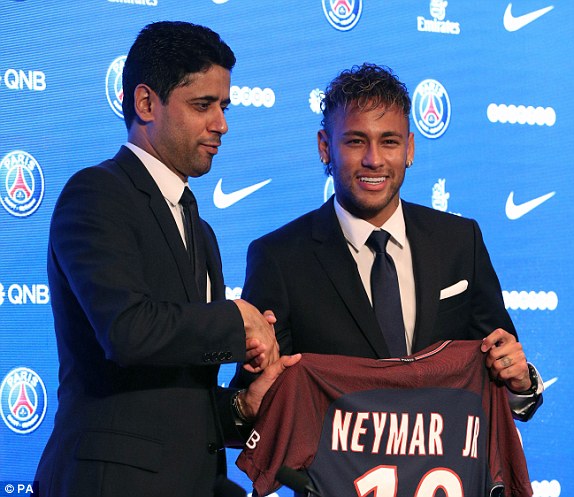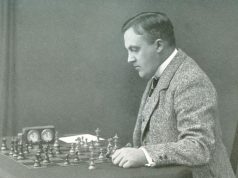The deal is done. Brazilian striker Neymar has been officially unveiled by Paris Saint-Germain (PSG) after completing his world-record 198 million pounds transfer from Barcelona. Neymar signed a 5-year contract with PSG, his new club after spending 4 seasons in Barcelona. Before moving to Paris,

25-year old Neymar visited his Barcelona mates where he enjoyed some of the biggest moments of his career.
Neymar’s move will go down in history after more than doubling the previous world record transfer fee. The new entrant in Paris sported his new football colours as he was greeted by huge crowds of fans. Club president Nasser Al-Khelaifi was ecstatic and said, “For me Neymar is the best player in the world, so we wanted to have the best player in the world.” What is blowing in the wind is, Neymar’s decision of leaving Barca was perhaps motivated by the thought of moving away from the shadow of Lionel Messi. But the star footballer vehemently denied the accusation by saying, “No, quite on the contrary. One of my motivations to play for Barcelona was to play alongside Lionel Messi, he was my role model.” On the issue of money, he added, “What I say to these people is they don’t know anything about my personal life, I was never motivated by money. What I think about is my happiness and together with my family. I am here to write history.”
History Of Transfer
Neymar might deny allegation of financial motivation, but his signing has re-written football history in many ways. The first transfer in the history of football, perhaps, has taken place in 1893 when Scottish footballer Willie Groves moved from West Bromwich Albion to Aston Villa for a sum of 100 pounds. Although
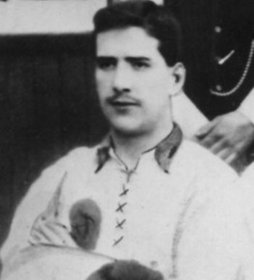
Groves went on to win the league with Villa, he left a year later due to an internal dispute concerning his contract. The 100 pound transfer fee of Groves shocked many in 1893, but it took just 12 years for the figure to become 1,000 pounds when Alf Common changed from Sunderland to Middlesbrough.
Transfers began in football history sometime after 1885, when the Football Association in England introduced a player registration system. According to the registration process, players had to register with a club each season, even if he remained with the same club from the season before. The players however, were free to join another club before the start of each season, even if their former club wished to retain them. But this led to the dominance of some richer clubs in European football. As the Football League was introduced in 1888, it was decided to have restrictions on the ability of richer clubs to tempt players financially. It was initiated that once a player was registered with a Football League club, he could not be registered with any other club, even in subsequent seasons, without the permission of the club he was registered with.
Meanwhile, in 1904, Fédération Internationale de Football Association (FIFA) was formed as
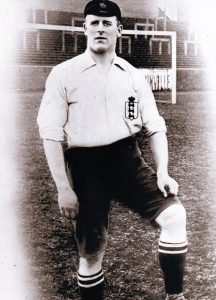
the governing body for world football. It promulgated new transfer regulations. It also permitted continental confederation to create its own transfer regulations. Union of European Football Associations (UEFA) which was formed under FIFA to govern European football took advantage of this right. It gave each player a right to transfer to a foreign club when his contract with his then-current club expired, but the player’s new club had to pay a transfer fee to the player’s former club. This was a great benefit and a source of revenue for the player’s former club, and not surprisingly a burden for the new club. At the same time, FIFA regulations also provided that an international transfer could only take place if the former national association issued a transfer certificate acknowledging that all financial commitments, including any transfer fee, had been settled.
Path-breaking Bosman Ruling Changes Transfer Scenario
Unsurprisingly, players disliked this regulation of withholding the transfer certificate. One such player was Jean-Marc Bosman, a Belgian national who played for RFC Liège in Belgian First Division Football. Bosman’s contract expired in 1990 and he wanted to move to Dunkerque, a French club. However, Dunkerque refused to meet the transfer fee of 500,000 pounds as demanded by Liège. Thus, according to FIFA’s rule Bosman’s Belgian club refused to issue transfer certificate to him. Not only that, Bosman’s wages was reduced as he was no longer a first-team
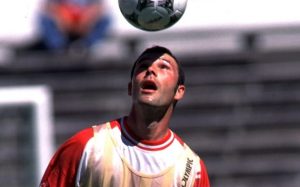
player. He took his case to the European Court of Justice in Luxembourg and after a lengthy legal battle, won his case on 15 December 1995. The justice issued ruled that players should legally be free to move when their contract expired.
Another impact the case had was the rules regarding foreign players. Before the ruling was made, clubs throughout Europe could only play a maximum of three foreign players in European competition. With the court order, it was open for the teams to field 11 foreign players if they wanted. Bosman later told, “I think I did something very good. I gave people rights. Now I think there may be a new generation of players who don’t realise how lucky they are to be able to leave a club and join another, even if they are the fifth or sixth foreigner there.”
Famous Transfers in Football World
Players moving from one club to another was already a phenomenal event soon after transfer system started in football. Money flowed when Luis Suarez (the Spaniard) moved from Barcelona to Inter Milan for 152,000 pounds in 1961 or Johan Cruyff moved from Ajax to Barcelona in 1973 for 922,000 pounds.

High-profile profile players were transferred in record fees but those records were ready to be broken in 5-6 years of time. It was during this time that Diego Maradona broke the transfer record twice as he moved first from Boca Juniors to Barcelona for 3million pounds and then to Napoli for 5million pounds. But after the Bosman’s Ruling came into effect, a year-by-year succession of record-breaking transfers started.
In 1996 Alan Shearer was transferred from Blackburn Rovers to Newcastle United for a fee of 15million pounds. Brazilian Ronaldo broke that record in 1997 when he moved to Inter Milan from FC Barcelona for a fee of 17million pounds. In the following year, everyone was surprised when Ronaldo’s national teammate Denílson shifted from São Paulo to Real Betis for a fee of approximately 21 million pounds. In 1999, Inter Milan splurged a whopping 28 million pounds for Christian Vieri from Lazio. But Lazio came back strongly the next year when they signed Herman Crespo of Parma for more than 30 million pounds to break the previous record. But Lazio’s record –breaking transfer was short-lived as within two weeks, Portugese Luis Figo controversially moved for 37 million pounds to Real Madrid from Barcelona. A year later, Spanish club further increased the record by signing Frenchman Zinedine Zidane for 48million pounds.

Zidiane’s record stood tall till 2009. It was Real Madrid again and this time they spent money for Christiano Ronaldo, undoubtedly one of the greatest footballers of present time. Roanldo transferred from Manchestar United to Madrid for 80 million pound-a straight rise of 32 million pounds from the days of Zidane. No one could stop Real Madrid from breaking another record as they signed Gareth Bale from Tottenham Hotspur in 2013 for around 85.1 million pounds. In 2016, Manchester United eventually took the record away from Real Madrid, signing French striker Paul Pogba from Juventus for 89million pounds.
Transfer Of Neymar Brings A Shift In Football Power
But the mother of all transfers was indeed this one…the one that happened just three days before. Neymar was a superstar but Barcelona could never believe that their buyout clause for the Brazilian would be activated .Europe is definitely the largest transfer market in the world as it has the most successful, well-known clubs with the best players of the world.

But Neymar’s acquisition might signal a shift in the power balance among Europe’s elite clubs. Barcelona’s illustrious history could not match the raw financial clout of PSG, owned by Qatar Sports Investments. Yet, it indicates the control of oil power in the soccer world.
By signing the Brazilian star, Qatar projected itself a business-like-image to investors after two months of intense diplomatic dispute with Saudi Arabia, the United Arab Emirates, Egypt and Bahrain. Neymar’s PSG move was intended at a tumultuous time for Qatar and it was the best effort to bring Doha in a positive centrestage through one of the biggest story of the year in the world’s favourite sport.
The other major factor that drove this multi-million transfer deal is the need for instant success for PSG. In modern football, there is no time for the managers to patiently develop teams and nurture homegrown talent that could win titles. In this era of exposure and glamour , football clubs need immediate results. So, club owners make no investments in time, rather invest on proven superstars.
How Neymar Will Be Profited
PSG’s humiliating 1-6 loss to Barcelona in the Round of 16 of last UEFA Champions League at Camp Nou might have prompted them to take this leap. Neymar, himself scored two goals in the match as Barcelona produced the greatest comeback in Champions League history completing an astonishing 6-5 aggregate success. The signing of Neymar is seen as a revenge taken by PSG and as well as moving forward to achieve their ultimate goal of winning the UEFA League.
Among this entire hullabaloo, Neymar is the person who is having the laugh. It’s a calculated move by the young player who knows that his best years are yet to come and he could become the best player of his generation. In his 4 seasons in Barcelona, Neymar scored 105 goals and produced 59 assists. He won eight titles with Barcelona, including their historic treble in 2015-16. Neymar knows that at PSG, he will be the ultimate player of the team. He has no big name in front of him and if he thrives in France along with a career-defining performance in the upcoming World Cup, then Neymar could possibly win his most coveted Ballon d’ Honour.

